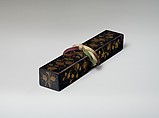Scroll Box (Jikumono-bako) with Paulownia and Autumn Grasses
Not on view
In the Momoyama period (1573–1615), a new style of lacquer decoration developed in Kyoto. Named after the Kōdaiji Temple, it catered to the tastes of the warlord Toyotomi Hideyoshi (1537–1598) for flamboyant furniture and household items decorated in gold. Using several relatively simple techniques, craftsmen conceived innovative, bold designs that did not require complicated underdrawings and allowed them to cover large surfaces in short amounts of time. The designs on this scroll box are executed in flat gold hiramaki-e with darker “pear-skin” hues to create a striking contrast with the black lacquer background.
This image cannot be enlarged, viewed at full screen, or downloaded.

